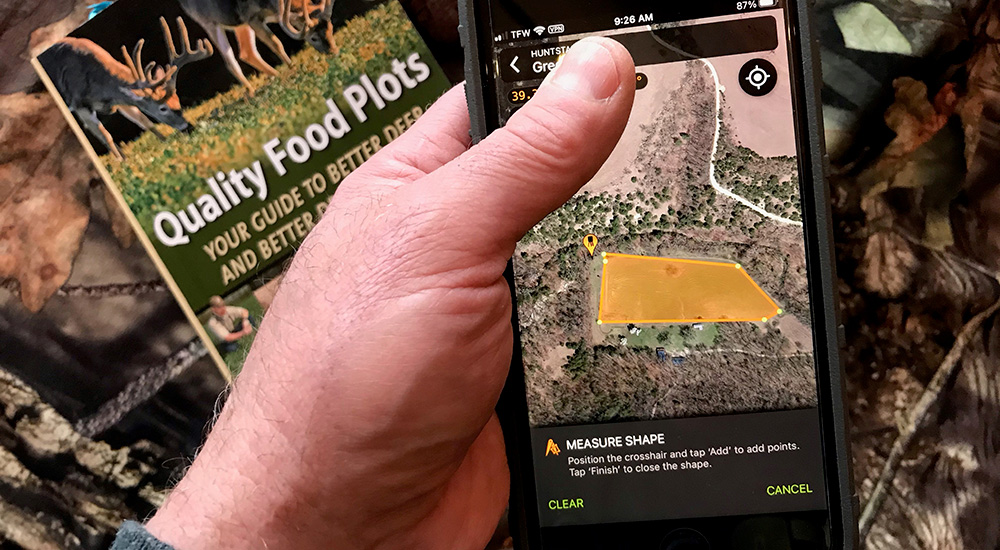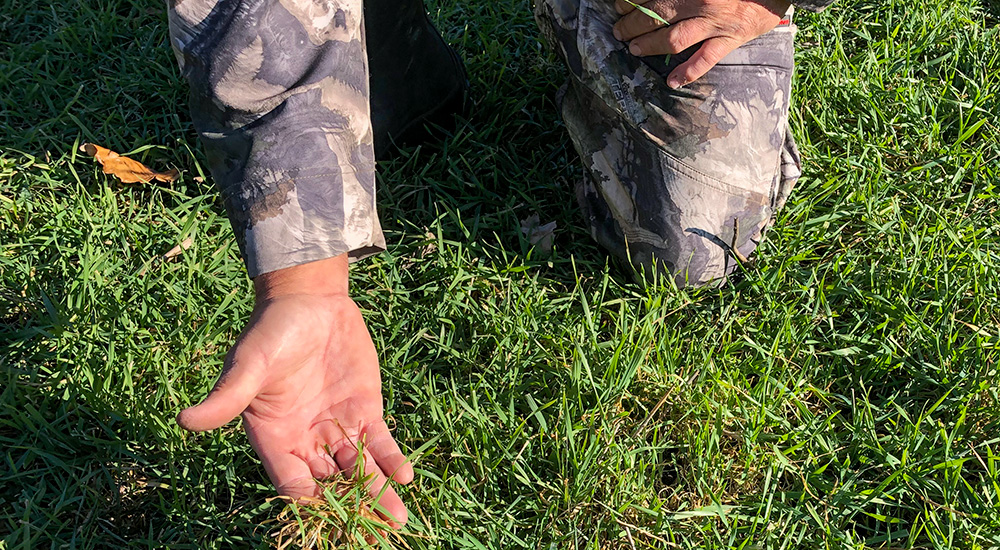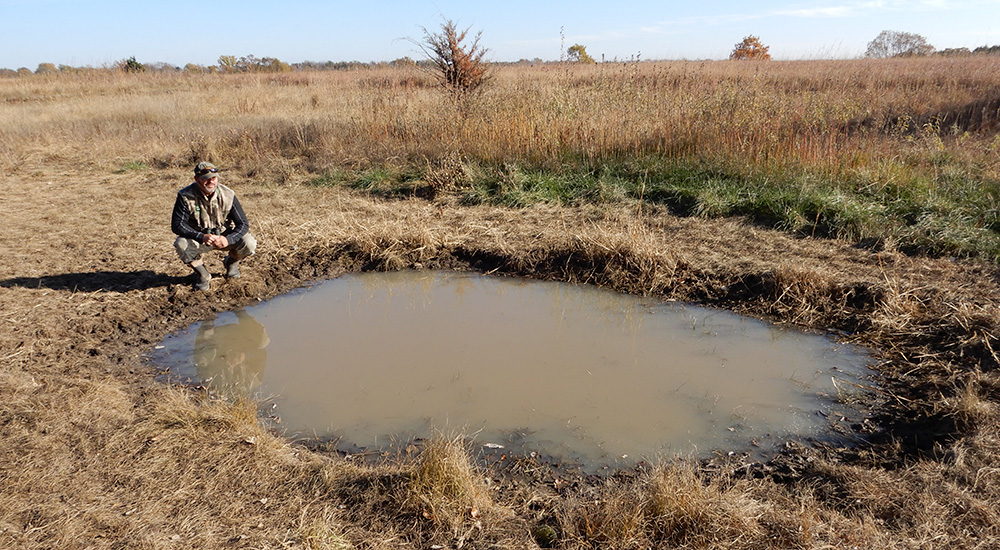
Hunting properties vary in size and habitat like the demographics of the American public. Even with this wide-ranging diversity you can create a plan to optimize your property with the basics of shelter, food and water. Designing and designating areas of your property for these essentials now pays off later in hunting season as deer perceive the reliance on the cornerstones of life.
Hunting apps provide a unique tool for designing hunting properties. First, you get an aerial view from above to appraise a property while at home or on-site in the palm of your hand. For instance, the HuntStand app allows you to draw shapes to establish future sanctuaries, food plots and even mark potential water sources for development. Overlays allow you to view topographical information, trails, property boundaries and virtually fly over with 3D mapping.

A distance and shape calculator aid you in measuring acres and even shooting distance across a future food plot. When you finally move on to food plot implementation, the size calculations assist you in lime, seed, fertilizer and even fuel needs to get the job complete. Here are the fundamentals for the planning stage.
Sanctuary a Must
An easy addition to nearly every property is the creation of a sanctuary zone that includes no trespassing by anyone. You could break this access rule occasionally, for tracking wounded game or a quick hike to snatch a shed antler. Nevertheless, providing an escape zone where deer feel safe builds confidence for deer to stay on your property. Stay out of that designated area during hunting season and deer, near or far, will soon realize it to be the place for an undisturbed nap.
A rule of thumb to follow when designating off-limit areas is to follow the lead of the deer. Their bedding areas typically represent the most sheltered, dense and best hideouts on a property. Expand the perimeter beyond the normal bedding, and you provide a safe space for deer to get relief from your hunting pressure, and the neighbors. No rule states the amount of sanctuary required on a property, but more is better. If the parcel allows, set aside 50 percent of it for a safe space and hunt food plots, mast hollows and major travel corridors surrounding the sanctuary.
Art Helin creates habitat consultation plans for Midwest properties that include year-round food sources, water and refuge for wildlife. After more than three decades of whitetail hunting experience, he understands the importance of an extensive sanctuary for wildlife, especially deer. He also knows that every property does not have all the escape cover required. In addition to considering the planting of cloaking crops, such as Egyptian wheat, Helin uses trees he has cleared from food plots and stacks them in scouted areas to create bedding areas.
“As a secondary benefit, the large piles of downed timber provide view-blocking obstructions that allow me or clients to sneak in and out of hunting stands behind the stacks without being seen. With the right wind, it is just another way to minimize your presence on a property.”
A Food Foundation
Some properties include openings and space for tillable food plots. Others do not. If your property has arable land, put it into play during your architectural property design. Native mast, forestry enhancements and even supplemental food, when legally allowed, all play into an overall nutrition program for a property, but having a centralized food bank available 24/7, 365 days per year appeals to creature comfort-loving whitetails.
 To keep deer on your property this fall, think now about shelter, food and water, must-haves for wildlife anywhere.
To keep deer on your property this fall, think now about shelter, food and water, must-haves for wildlife anywhere.
Centralized is key. Although a sanctuary could rest along a border fence and attract neighboring deer, food sources situated centrally on a property lure deer inwards and away from prying eyes or fence-line encounters.
Like sanctuary, more is better when it comes to food plots; many in management advise having nearly 5 percent of your property in food. Austin Delano is a 16-year veteran at Mossy Oak Biologic. Delano oversees research and development, and heads up all property management products.
“If you have the means and you have 5 acres of open ground, don’t just plant a quarter acre. Plant as much as you can afford to plant,” stresses Delano. “Definitely look at aerial maps. They are gold for knowing property. And by analyzing how deer traveled in the past, we typically place a food plot before they get to bedding cover. Ideally for hunting, safety and escape cover, have food close by for deer to easily tap into. “
Helin agrees that more is better for food, and positioning food sources outside a sanctuary gives you an advantage of getting into a stand before they arrive from bedding cover.
“Keep your food plots at least 100 yards away from any sanctuary and downwind. Your goal is to draw them out and, after feeding, allow them to return to where they feel safe, whether they experience pressure or not.”
Helin has a final thought on planning food plots: Create them to accommodate your hunting style. He understands large fields can be challenging for bowhunting shots, but that size will work if firearm hunting is your choice. Also, planning it all in one place may be your only option, but planting two or more smaller food plots allows you to diversify nutritional options, reduce over-browsing and create more hunting areas.
Water When Possible
Water rounds out the third important element of sustaining wildlife. Although water abounds nearly everywhere in some regions, having it available on your property, near food or bedding sanctuary, helps convince deer to stay at home. Draft it into your plan.
Helin embraces the water-near-food concept, but also develops water near sanctuary as an added ambush site without having to invade bedding cover. His trail-camera images confirm that deer visiting food plots water at those sites and refill at water sources near refuge.

“My personal favorite time to hunt water is during the October lull,” points out Helin. “When that hits, a lot of those deer start laying low. They are trying to put on weight and not moving far. Instead of making them move any distance for water, I’ll put water near food sources. I also develop water on ridges, when possible, near bedding areas. In October, when other areas die, those places can be productive, especially on hot days.”
The easiest way to add water is to improve existing water sources. Dugouts near springs or seeps are good, especially if you line them with membranes designed to hold water. In spring and summer, deer may not even visit a water source as they often get much of their moisture from lush vegetation. As summer vegetation matures and heat evaporates hodgepodge water sources, a consistent water source could spring to life. Water becomes particularly essential during the rut as athletic, breeding bucks race to it like NFL players guzzling Gatorade on the sidelines.
An hour or more of planning now has big potential for your fall plans and years beyond as your property matures into a wildlife management success.



































